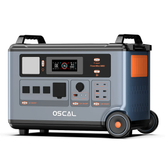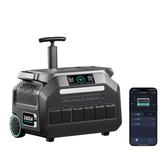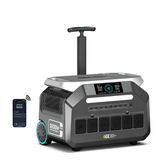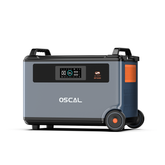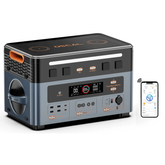Portable Power Station Buying Guide
Portable power stations and solar generators have become essential tools for modern living. Whether you are planning a camping trip, preparing for emergencies, or simply looking for a reliable power backup at home, choosing the right model can make all the difference. With so many options on the market, it’s easy to feel overwhelmed. This buying guide will walk you through the most important factors to consider so you can make an informed and confident decision.

1. Identify Your Main Purpose
Before comparing specifications, think about how you plan to use your portable power station.
- Camping & Outdoor Adventures: You’ll want something lightweight, easy to carry, with enough power to run lights, phones, or a mini cooler.
- Home Backup & Emergencies: Look for higher capacity models that can keep essential devices like routers, medical equipment, or even small appliances running.
- Professional Use: If you need power for tools, photography equipment, or mobile offices, prioritize higher wattage and multiple outlets.
Knowing your main purpose will quickly narrow down the choices.
2. Check Power Capacity
Power capacity is usually measured in watt-hours (Wh). This number tells you how long a power station can run your devices.
- 300–500Wh: Best for short trips, charging phones, tablets, or small lights.
- 500–1000Wh: Good balance between portability and power. Suitable for weekend camping or powering laptops and mini-fridges.
- 1000Wh and above: Ideal for emergencies and heavy-duty use. Can support appliances like CPAP machines, TVs, or even microwaves for short periods.
Example: A 500Wh unit can charge a 60W laptop about eight times.
3. Consider Output Ports
The type and number of output ports determine what you can plug in.
- USB-A & USB-C ports: For smartphones, tablets, cameras.
- AC outlets: For household appliances and larger electronics.
- DC carports: Useful for coolers and certain camping gear.
A well-designed power station should offer a mix of ports so you don’t need extra adapters.
4. Look at Power Rating (Watts)
Capacity tells you how much power is stored, while wattage tells you how much power the station can deliver at once.
- 300W or lower: Great for small devices, but not for appliances.
- 500–1000W: Covers most needs including laptops, routers, small fans.
- Over 1000W: Can handle heavy-duty devices like kettles, coffee makers, or power tools.
Note: If you try to plug in something beyond the wattage limit, the station will shut off automatically.
5. Charging Methods
How quickly can you recharge your power station? Look for multiple options:
- AC wall charging: Fastest and most common method.
- Car charging: Useful during road trips.
- Solar panel charging: Best for sustainable, off-grid use.
If you plan on long outdoor adventures, a model with solar input compatibility is highly recommended.
6. Portability and Design
Think about how and where you will carry your power station.
- Weight: Compact models can be under 10 lbs, while large ones may exceed 40 lbs.
- Handles or wheels: Make transportation easier.
- Durability: Rugged designs are better for outdoor use.
For regular camping, a lightweight unit is more practical. For home backup, weight is less of a concern.
7. Battery Type
Most modern power stations use lithium-ion batteries, which are lightweight and efficient. High-end models may use LiFePO4 batteries, which offer longer lifespans and higher safety.
- Lithium-ion: Affordable, compact, up to 500–1000 charge cycles.
- LiFePO4: More expensive, bulkier, but last 3000+ charge cycles.
If you plan frequent use, LiFePO4 is worth the investment.
8. Extra Features
Some models come with useful extras:
- LCD screen: Displays remaining power, charging time, and usage.
- Wireless charging pads: Convenient for phones.
- App connectivity: Monitor and control via smartphone.
- Built-in flashlight: Handy for emergencies.
While not essential, these features can make daily use more convenient.
9. Budget Considerations
Prices vary widely depending on capacity and features:
- Entry-level models: $200–$400
- Mid-range models: $500–$1000
- High-capacity models: $1000+
Always balance budget with actual needs. Buying the biggest model may seem safe, but it can be unnecessary if you only need power for small gadgets.
10. Brand and Warranty
Not all portable power stations are created equal. Choosing a reliable brand ensures safety, durability, and proper after-sales service.
- Warranty: Look for at least 1–2 years coverage.
- Certifications: CE, FCC, RoHS for international safety standards.
- Customer support: Check reviews and responsiveness.
A good brand will also offer replacement parts or accessories, such as compatible solar panels.
Final Thoughts
Buying a portable power station is not just about picking the biggest or cheapest option. It’s about finding the right match for your lifestyle, whether that means a lightweight unit for weekend camping or a powerful backup for emergencies.
By considering capacity, output ports, wattage, charging methods, and design, you can confidently choose a model that meets your needs. And once you experience the convenience of reliable portable power, you’ll wonder how you ever managed without it.

